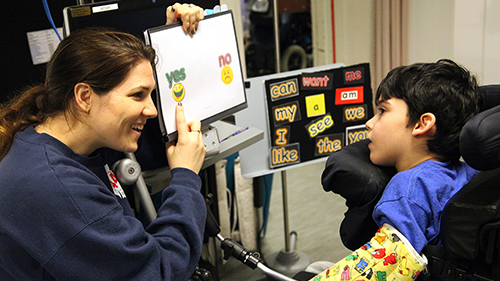At The Bridge School, supporting communicative competence means helping students to have successful interactions with diverse partners across multiple environments. This often means increasing the number of communication partners a student interacts with, varying the familiarity level of partners (familiar versus less familiar versus unfamiliar), and/or the types of partners (typically-developing peer, classmate, teacher, etc.). When students are learning new operational, strategic, social and linguistic skills, they need opportunities for regular practice with supportive communication partners.

Supportive partners help develop, expand and trouble-shoot AAC systems, utilize interaction strategies to facilitate conversations and promote active participation in social and academic activities. Research shows that parents, caregivers and peers can readily learn supportive interaction strategies. When partner training programs occur in natural contexts, researchers report that gains are seen quickly and maintained over time (Kent-Walsh & McNaughton 2005; Collier, McGhie-Richmond, & Self 2010).
References
Collier, B., McGhie-Richmond, D., & Self, H. (2010). Exploring communication assistants as an option for increasing communication access to communities for people who use augmentative communication. Augmentative and Alternative Communication, 26, 48-59.
Kent-Walsh, J., Binger, C., & Hasham, Z. (2010). Effects of Parent Instruction on the Symbolic Communication of Children Using Augmentative and Alternative Communication During Storybook Reading. American Journal of Speech-Language Pathology, Vol. 19, 97-107.
Light, J. & McNaughton, D. (2014). Communicative Competence for individuals who require augmentative and alternative communication: A new definition for a new era of communication? Augmentative and Alternative Communication, 30:1, p1-18.

